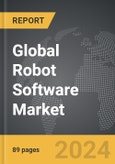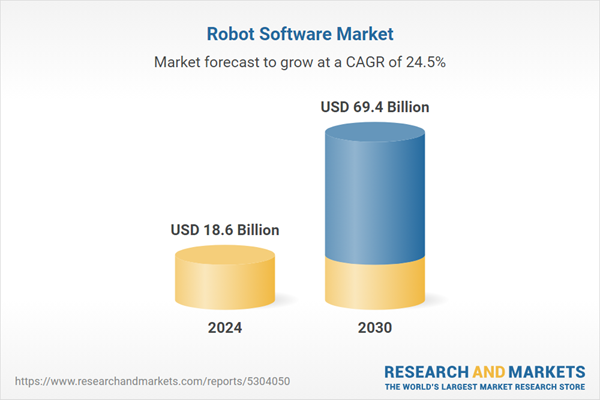The global market for Robot Software was valued at US$18.6 Billion in 2024 and is projected to reach US$69.4 Billion by 2030, growing at a CAGR of 24.5% from 2024 to 2030. This comprehensive report provides an in-depth analysis of market trends, drivers, and forecasts, helping you make informed business decisions. The report includes the most recent global tariff developments and how they impact the Robot Software market.
Segments: Software Type (Data Management & Analysis Software, Recognition Software, Communication Management Software, Simulation Software, Predictive Maintenance Software); Robot Type (Industrial, Service); Vertical (Manufacturing, Healthcare, Aerospace & Defense, Media & Entertainment, Logistics, Other Verticals).
Geographic Regions/Countries: World; United States; Canada; Japan; China; Europe (France; Germany; Italy; United Kingdom; and Rest of Europe); Asia-Pacific; Rest of World.
The analysts continuously track trade developments worldwide, drawing insights from leading global economists and over 200 industry and policy institutions, including think tanks, trade organizations, and national economic advisory bodies. This intelligence is integrated into forecasting models to provide timely, data-driven analysis of emerging risks and opportunities.
Global Robot Software Market - Key Trends and Drivers Summarized
How Is Robot Software Transforming Automation and Industry 4.0?
Robot software is the backbone of robotic automation, enabling robots to perform complex tasks, learn from data, and interact intelligently with their environments. This software manages the hardware, interfaces, and programming languages that allow robots to perform tasks accurately and efficiently. Robot software is essential in industries that require high precision and repeatability, such as automotive manufacturing, electronics, and logistics. With the rise of Industry 4.0, the demand for advanced robotic software has increased, supporting innovations like machine learning and AI that allow robots to adapt to changing conditions and improve over time.What Are the Key Segments in the Robot Software Market?
Major types include simulation software, predictive maintenance software, data management software, and AI-based software. Simulation software holds a significant share as it allows users to design and test robotic systems in virtual environments before deployment, reducing costs and time. Applications include robot operations, programming, data management, and predictive maintenance, with robot programming being the largest segment due to the need for customizable software across various robotic systems. End-user industries for robot software include manufacturing, automotive, healthcare, and logistics. The manufacturing industry leads the market due to the extensive use of robotics in assembly lines and production processes. The automotive sector heavily relies on robot software to operate robotic arms and AGVs for efficient assembly and material handling. Healthcare utilizes robot software in surgical robots and diagnostic equipment, enhancing precision and improving patient care. Logistics is another major user, leveraging software to optimize warehouse robots for inventory management and order fulfillment.How Is Robot Software Applied in Industrial and Commercial Automation?
In manufacturing, robot software enables precise control of robotic arms, allowing for efficient assembly and welding processes. In healthcare, robot software manages surgical robots, improving accuracy and consistency in minimally invasive procedures. Logistics companies use robotic software to optimize AGVs and drones for efficient inventory management and distribution, supporting the fast-paced demands of e-commerce. In the automotive industry, robot software is integral to automated production lines, operating robotic welders and assemblers that improve production speed and quality. The software is also critical for predictive maintenance, identifying potential issues before they disrupt production.What Factors Are Driving the Growth in the Robot Software Market?
The growth in the Robot Software market is driven by several factors, including the rise of Industry 4.0, increased use of AI, and growing adoption of robotics across industries. Innovations like cloud-based robot software, machine learning, and enhanced data analytics have expanded the capabilities of robot software, making it more adaptive and efficient. The focus on improving operational efficiency, reducing downtime, and enabling predictive maintenance has further fueled demand, as robot software provides essential automation support. Additionally, growth in sectors like manufacturing, healthcare, and e-commerce, coupled with advances in AI and big data, has contributed to market growth, supporting broader adoption and development of sophisticated robot software solutions.Report Scope
The report analyzes the Robot Software market, presented in terms of units. The analysis covers the key segments and geographic regions outlined below.Segments: Software Type (Data Management & Analysis Software, Recognition Software, Communication Management Software, Simulation Software, Predictive Maintenance Software); Robot Type (Industrial, Service); Vertical (Manufacturing, Healthcare, Aerospace & Defense, Media & Entertainment, Logistics, Other Verticals).
Geographic Regions/Countries: World; United States; Canada; Japan; China; Europe (France; Germany; Italy; United Kingdom; and Rest of Europe); Asia-Pacific; Rest of World.
Key Insights:
- Market Growth: Understand the significant growth trajectory of the Data Management & Analysis Software segment, which is expected to reach US$32.0 Billion by 2030 with a CAGR of a 27.6%. The Recognition Software segment is also set to grow at 21.6% CAGR over the analysis period.
- Regional Analysis: Gain insights into the U.S. market, valued at $5.5 Billion in 2024, and China, forecasted to grow at an impressive 23.5% CAGR to reach $10.4 Billion by 2030. Discover growth trends in other key regions, including Japan, Canada, Germany, and the Asia-Pacific.
Why You Should Buy This Report:
- Detailed Market Analysis: Access a thorough analysis of the Global Robot Software Market, covering all major geographic regions and market segments.
- Competitive Insights: Get an overview of the competitive landscape, including the market presence of major players across different geographies.
- Future Trends and Drivers: Understand the key trends and drivers shaping the future of the Global Robot Software Market.
- Actionable Insights: Benefit from actionable insights that can help you identify new revenue opportunities and make strategic business decisions.
Key Questions Answered:
- How is the Global Robot Software Market expected to evolve by 2030?
- What are the main drivers and restraints affecting the market?
- Which market segments will grow the most over the forecast period?
- How will market shares for different regions and segments change by 2030?
- Who are the leading players in the market, and what are their prospects?
Report Features:
- Comprehensive Market Data: Independent analysis of annual sales and market forecasts in US$ Million from 2024 to 2030.
- In-Depth Regional Analysis: Detailed insights into key markets, including the U.S., China, Japan, Canada, Europe, Asia-Pacific, Latin America, Middle East, and Africa.
- Company Profiles: Coverage of players such as ABB Ltd, Aibrain, Brain Corporation, Cloudminds, Energid technologies and more.
- Complimentary Updates: Receive free report updates for one year to keep you informed of the latest market developments.
Some of the 33 companies featured in this Robot Software market report include:
- ABB Ltd
- Aibrain
- Brain Corporation
- Cloudminds
- Energid technologies
- Epson Robotics
- Furhat robotics
- IBM Corporation
- iRobot
- Microsoft Corporation
- Neurala
- Nvidia Corporation
- Oxbotica
Tariff Impact Analysis: Key Insights for 2025
Global tariff negotiations across 180+ countries are reshaping supply chains, costs, and competitiveness. This report reflects the latest developments as of April 2025 and incorporates forward-looking insights into the market outlook.The analysts continuously track trade developments worldwide, drawing insights from leading global economists and over 200 industry and policy institutions, including think tanks, trade organizations, and national economic advisory bodies. This intelligence is integrated into forecasting models to provide timely, data-driven analysis of emerging risks and opportunities.
What’s Included in This Edition:
- Tariff-adjusted market forecasts by region and segment
- Analysis of cost and supply chain implications by sourcing and trade exposure
- Strategic insights into geographic shifts
Buyers receive a free July 2025 update with:
- Finalized tariff impacts and new trade agreement effects
- Updated projections reflecting global sourcing and cost shifts
- Expanded country-specific coverage across the industry
Table of Contents
I. METHODOLOGYII. EXECUTIVE SUMMARY2. FOCUS ON SELECT PLAYERSIII. MARKET ANALYSISIV. COMPETITION
1. MARKET OVERVIEW
3. MARKET TRENDS & DRIVERS
4. GLOBAL MARKET PERSPECTIVE
UNITED STATES
CANADA
JAPAN
CHINA
EUROPE
FRANCE
GERMANY
ITALY
UNITED KINGDOM
REST OF EUROPE
ASIA-PACIFIC
REST OF WORLD
Companies Mentioned (Partial List)
A selection of companies mentioned in this report includes, but is not limited to:
- ABB Ltd
- Aibrain
- Brain Corporation
- Cloudminds
- Energid technologies
- Epson Robotics
- Furhat robotics
- IBM Corporation
- iRobot
- Microsoft Corporation
- Neurala
- Nvidia Corporation
- Oxbotica
Table Information
| Report Attribute | Details |
|---|---|
| No. of Pages | 89 |
| Published | April 2025 |
| Forecast Period | 2024 - 2030 |
| Estimated Market Value ( USD | $ 18.6 Billion |
| Forecasted Market Value ( USD | $ 69.4 Billion |
| Compound Annual Growth Rate | 24.5% |
| Regions Covered | Global |









